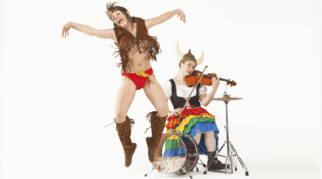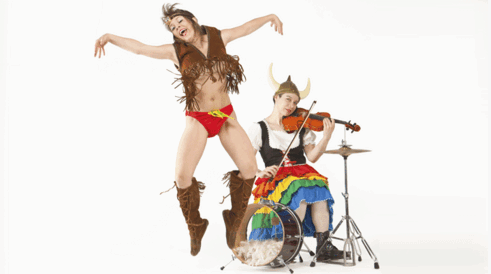
The second and final weekend of the Northwest New Works Festival at On the Boards is in the can, a collection of works that entertained with spectacle and enigma, provoked less than you might expect, and sometimes gave insight, directly and glancingly, on social issues.
Working backwards from mainstage to studio, DAE’s Haruko Nishimura teamed up with a modern chamber orchestra for Grandmother Mothra’s Mercurial Tale, which I believe is an excerpt from her epic, site-specific Red Shoes. The music, by Joshua Kohl (who also conducted) and Jherek Bischoff, fit within Kohl’s capacious “classico-punk-big band” genre, reminding me a little of Faun Fables’ eclecticism, though Nishimura’s vocals suggested Bjork (Brendan Kiley says Joanna Newsom). The piece began with Nishimura, seated on the floor, jerking in suitable creepy doll-coming-to-life fashion (Amy O’Neal is listed as the collaborative choreographer for this first section), before adopting a Little Red Riding Hood persona, and meeting alter-ego wolf in the forest (performed on video screens, which Nishimura eventually “jumps” into). Their conversation brings to mind both Robert Coover and Buddhist demonology, but dramatically the stakes are low, so the work’s aesthetic appeals are what linger.
Shannon Stewart‘s A Better Container contained a more perplexing combination of an almost David Lynchian introduction (to a crooner’s song, a woman in a ’60s dress dances with her back to you, her ’60s hair cascading down, then turns to reveal a face that’s also obscured by hair, at which point you inevitably think of Cousin It) and a physical rewind (either through generations, or one woman’s life). The crooner, a glamorously white-suited Sam Mickens, intrudes into this space, too, singing a fragment of song as if unaware he’s a record skipping, and old console TVs display a shadowy glimpse of his performance (Adam Sekuler did the video work). The women (Marissa Rae Niederhauser, Shannon Stewart, Lenore Waldon, and Ellie Hughes) walk backwards diagonally across the stage (then hotfoot it from the wings through the lobby and back around, to enter again in an unbroken line), transmitting movements to each other, snapping heels down, reaching for invisible things. This proceeds for longer, I thought, than is necessary to get the idea. But then Niederhauser leads Stewart (I think) by her arm into a duet of sorts, and you feel at last that something is happening other than reverie, even if you are not sure what it is.
The Blank Department‘s deeper-than-it-looks Orders of Magnitude featured a band (Drew Dillhunt, Jed Dunkerley, Jenelle Greninger, Mike Katell, Jason Puccinelli), an Adam-and-Eve copulating couple (David Nixon, Sara Edwards), and a befuddled professor (Basil Harris), who announces the events that follow as a sort of seminar on the Big Bang and evolution. More microcosmically, it’s a diorama of sex, getting things, things falling apart, and starting over. Lead vocalist Dillhunt excuse me, Jed Dunkerley somehow construes lines like “bodies big and armor strong / had been our saviors for so long / but when the sky begins to fall / they won’t protect us after all” as indie rock ballad lyrics, as Nixon and Edwards strip down for hot Big Bang action (bathed in sculptural light from ilvs strauss, with Harris nipping about, embarrassedly gathering undergarments), collect dinosaur bones, very cleverly use them as a metaphor for burdensome protection, and then collapse under their weight. The piece ends with an interrogation of roads taken–if you knew then what you know now, would you still…?
Aluminum Siding (Donna B. Isobel) and mattisonthemove (Matthew Smith) teamed up for TORN, which turned piles of sheets of paper into jaw-dropping, Seussian stalactites and stalagmites. In each dancer’s case, it felt more like a display of technique than the execution of a larger concept that informed their movement: Isobel appears first, throwing a pile of papers into the air and letting them engage in their own airborne choreography before snatching a sheet and setting up a pattern where it travels across and around her body, handed down her back, caught by an elbow or knee, tossed and grabbed again. Purely as performance, it’s attention-getting. Smith’s entrance is equally remarkable; he’s under a white-paper blanket, looking like an old Star Trek paper-mâché set piece, when he motors out and puts his paper-costume through its paces–it takes on life and distinct shapes. Eventually he emerges and he and Isobel dance in tandem with pieces of paper, elaborating on bodily mechanics, smoothly and at speeds that astonish.
In the studio, The FINGER Songbook brought “haunting madrigals about sex, death and produce”–multi-instrumentalist Julie Baldridge clowning musically with Queen Shmooquan’s Jeppa Hall, who clowns in every other way imaginable. From the opening ode to meat, with Hall stepping into too-large hiking boots and clomping around, the performance set a pleasantly whacked-out tone that felt positively Canadian.
Lori Hamar’s Blood Line was more serious, and a dance work that (it’s not immediately apparent) has to do with the internment of Ukrainians during WWI. It opens with a dancer flipping through photos on a smart phone (you see the video projected), and then there’s a remarkable set piece with three dancers and three chairs, which explores the chair as a dance partner. Late in the piece I either glimpsed or heard the word “internment” and thought, Wait, what?
Danielle Villegas offered Azteca la Curandera–As I see it. I’m still puzzling over the voiceover which began talking about the Mayan 2012 prophecy, Mayans and Aztecs not being the same thing (as I’m sure everyone involved does know), and Villegas’ piece, in any event, having more to do with sex roles and identity than mystic cataclysm. Elements of Villegas’ solo show (drumming by Marina Wiesenbach, directed by Lamar Van Dyke) are more successful than the whole. Villegas performs a stylized memoir about a tomboy who grows up to join the Marines, only to be drummed out due to DADT. Then she takes on the persona of an Aztec “two-spirit” healer, facing the arrival of conquistadors, and contrasts a rigid Western view of sexual identity (there’s just two!) with purportedly more flexible pre-contact options. The show ends making the assertion (forgivable, I’d say, if you take the title at face value, but not dramatically useful) that it’s better to be socially accepted for who you are.
A caveat about Quark Contemporary Dance Theatre‘s Toast–my bus was rerouted and I rushed into the studio as the lights were going down, not quite “ready” for the intimate, low-key drama being presented. A woman sits at a table, recounting how she used to make breakfast for someone (lover? daughter?) just the way she liked it. The other person has given her a kiss on the cheek, not on the lips, in parting (so…lover?) last. She has suspicions and doubts. As she speaks, the “other” in question dances about her, bracelets jangling, sometimes miming their interactions. Another woman is across the stage; she and the gone-missing woman dance; the woman returns to the toast-maker and they have a low-voiced rapprochement. The high point, for me, was a reading of a Julia Child recipe as a signal of infidelity, or the urge to roam, but otherwise, the heat here remained set on Low.

Puzzle answer: Azteca is only her name…